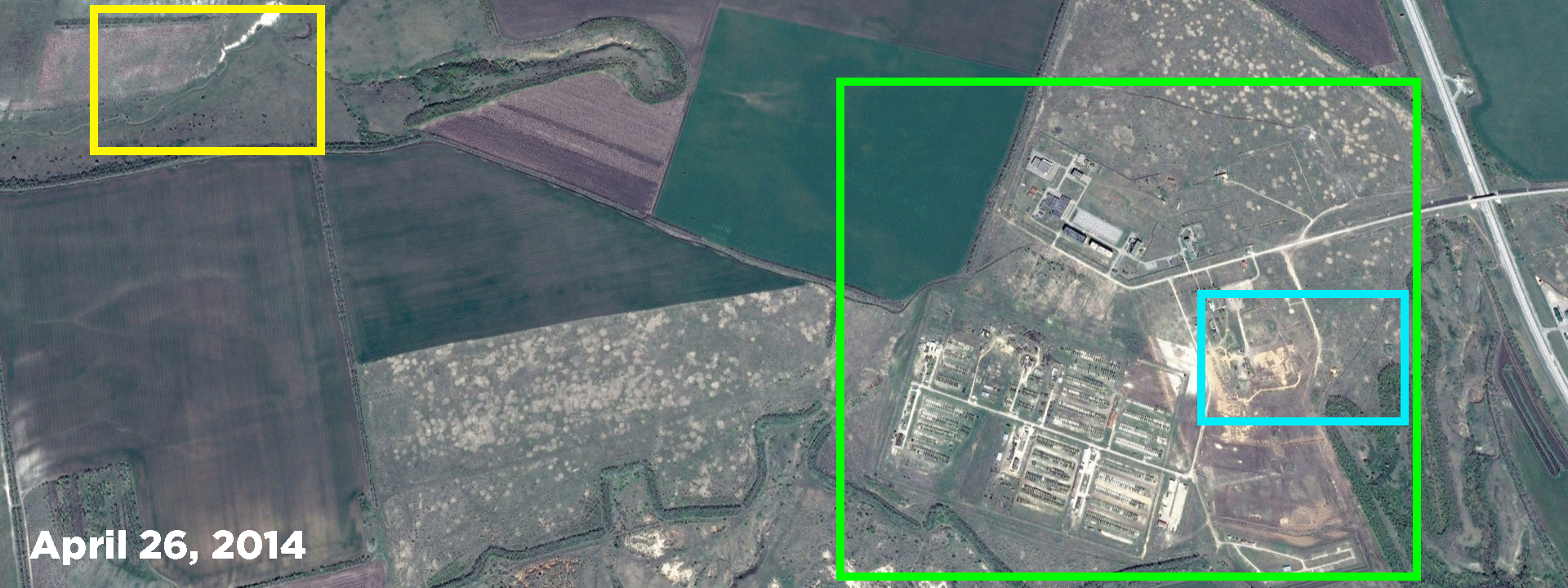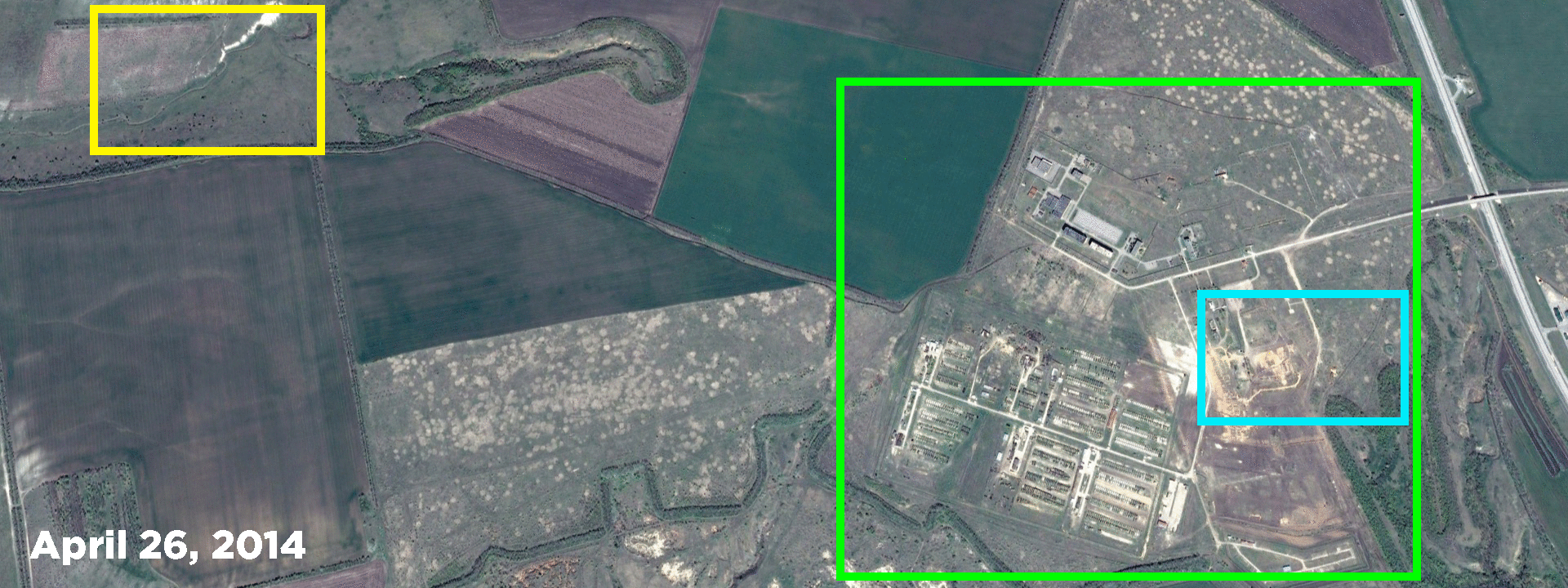Choo-Chooshka? New Russian Railway and Military Movement on the Ukrainian Border
Open source evidence suggests the potential for a buildup of forces
Choo-Chooshka? New Russian Railway and Military Movement on the Ukrainian Border

BANNER: The 262nd Russian equipment base in Boguchar, Voronezh Oblast, on April 26, 2014, April 9, 2016, and June 5, 2017. (Source: Google Earth)
Social media, press, and monitoring reports indicate a possible increased Russian military presence along Ukraine’s eastern border. Sightings of heavy weapons and vehicles are coinciding with the completion of a new high-speed railway line that can more easily and quickly transport freight, including military equipment, from central Russia to the Black Sea, without transiting Ukrainian territory (as the older line does). Both the completion of the railway line and the signs of an increased military presence point to the potential for even further military buildup in the future.
Attiva la linea ferroviaria #Zhuravka–#Millerovo che permetterà di collegare #Russia centrale e meridionale aggirando territorio #Ucraina pic.twitter.com/MuFupZhCbQ
— Marco Bordoni (@bordoni_russia) August 8, 2017
On August 11, state-operated Russian Railways (RZD) announced the completion of the Zhuravka-Millerovo high-speed railway, which bypasses Ukraine to reconnect central Russia to Voronezh Oblast, Rostov Oblast, and the Black Sea coast. Pre-existing rail tracks ran through a 26-kilometer (approximately 16 miles) section of government-controlled Luhansk Oblast, Ukraine, and Ukraine refused Russia access to that line after the Russian invasion of eastern Ukraine in 2014. The new high-speed line was reported to cost approximately RUB 55 billion (approximately USD 9.19 million).
The Jamestown Foundation, a think tank with a focus on Eurasia, reported that even though construction was to be carried out by RZD, Russian military forces became increasingly involved, with Russian Minister of Defense Sergei Shoigu calling the railway of “instrumental importance” for Russia. Looking at a map of the area, it is easy to see how the railway could increase Russia’s military logistical capabilities in the non-government-controlled areas of the Ukrainian border. This bypass railway constitutes key infrastructure for Russia should it choose to dramatically increase (in duration or volume) its military presence on Ukraine’s border or in the non-government-controlled areas of eastern Ukraine.
Both verified and unverified photographs and videos from late July and early August suggest military movement along the areas of Russia bordering Ukraine.

As @DFRLab reported in late July, the Organization for Security and Co-operation in Europe (OSCE) Special Monitoring Mission (SMM) to Ukraine observed multiple “military type” vehicles passing through a non-government-controlled checkpoint between Russia and Ukraine in both directions, suggesting either a possible military buildup or a seasonal rotation of forces. Since then, the OSCE SMM has observed significant military traffic and has continued to face restricted access to areas where they have previously observed military traffic.
Social media posts from the time period when OSCE SMM made these observations suggest that military equipment was passing through towns just outside of Rostov-on-Don, where Russia’s Southern Military District is headquartered, and was possibly headed toward the aforementioned checkpoint where the OSCE SMM faces frequent access restrictions.
Images in these social media posts show at least 25 tanks in Pokrovskoye, Rostov Oblast, the same town mentioned in a previous @DFRLab piece about Russian military movement in and around Ukraine. The train schedule for the Neklinovka train station in Pokrovskoye indicates that trains passing through the station travel between Uspenskaya, Taganrog, and Rostov-on-Don “Glavny” (the main station). Taganrog is just outside of Rostov-on-Don, and, as noted the same previous @DFRLab piece, is the point of origin for many “marshrutkas” (mini-buses) traveling to non-government-controlled eastern Ukraine.


The OSCE Observer Mission (OM) at the Russian checkpoints at Gukovo and Donetsk recorded a higher amount of train traffic during these weeks, more persons in military-style outfits crossing into Ukraine than into Russia in early July, and more persons crossing into Russia than into Ukraine in late July. Additionally, the OSCE OM issued a spot report for a Russian “humanitarian” convoy of 21 vehicles that crossed into Ukraine on July 27. Taken together, this information seems to indicate a rotation of troops and the restocking of equipment and supplies.
In a press briefing on August 15, Deputy Chief Monitor of the OSCE SMM Alexander Hug reported that SMM monitors observed members of the Russian military, as well as likely Russian military equipment, in the non-government-controlled areas of eastern Ukra
[facebook url=”https://www.facebook.com/oscesmm/videos/870924913059215/” /]
Military equipment was also seen in and around Volgograd, Voronezh, and Krasnodar (again in proximity to Russia’s Southern Military District base in Rostov-on-Don, the likely major hub for Russian military involvement in eastern Ukraine). Military activity in this area could indicate three different things: troop and equipment movement to Belarus for the 2017 Zapad military exercises; a seasonal rotation and replenishment of equipment to the non-government-controlled areas of the Luhansk and Donetsk oblasts in eastern Ukraine; or a buildup of Russian military forces along Ukraine’s border. It is perhaps most likely that all three of these factors play a role.

Instagram posts geotagged by a Russian soldier in Kantemirovka, Voronezh Oblast (a 20km drive from the Ukrainian border and connected to the major railroad), show military vehicles and equipment including “Tor-M2” surface-to-air missiles (SAM) (NATO reporting name SA-15 Gauntlet). Upgraded from the 9K331 “Tor-M1,” Tor-M2 SAMs are short-range systems designed to intercept aircraft, cruise missiles, precision-guided munitions, and unmanned aerial vehicles (UAVs). It is equipped with electronic countermeasures and can engage up to four targets simultaneously.
Tor-M2 SAMs were tested for the first time in early June 2017. Russian military divisions currently being trained with the new systems include the 150th Motorized Rifle Division of the Southern Military District based in Novocherkassk, Rostov Oblast, and the 4th Guards “Kantemirovskaya” Tank Division of the Western Military District based in Kapustin Yar, just outside of Volgograd, which is another location where military equipment was recently sighted in transit. After approximately 300 servicemen in each division have completed their training, the Tor-M2s will be permanently deployed to the bases. The training grounds of Kapustin Yar are home to frequent military exercises involving anti-aircraft equipment, especially in the summer.
Just over two weeks later, the same Russian soldier who had posted on Instagram the images of Tor-M2 SAM systems in Kantemirovka, Voronezh Oblast, posted images of the same Tor-M2 SAM systems in Boguchar, Voronezh Oblast, where Russia’s Western Military District operates the 262nd equipment base and the 1st Separate Tank Brigade.
Satellite imagery from Google Earth’s “historical imagery” feature shows that the Russian military base in Boguchar nearly doubled in size from April 9, 2016, to June 5, 2017, with an almost uncountable number of military vehicles clearly parked in a concentrated area.

An August 7 YouTube video shot near the Volga Hydroelectric Station in Volzhskiy, Volgograd Oblast (bordering Volgograd city), shows 9K37 Buk (NATO reporting name SA-11 Gadfly; SA-17 Grizzly) medium-range SAM missile systems, including multiple TELAR (launcher and radar) systems, being transported via train. Volgograd is farther from the Ukrainian border than the locations mentioned above. These systems were likely headed to Kapustin Yar for seasonal military exercises. As Bellingcat and @DFRLab have reported, a Buk-M1 missile system downed flight MH17.
The growing Russian military movement near the Ukrainian border is a disturbing development. Satellite imagery reflects an increased Russian military presence, with growing concentrations of military equipment and bases. This raises two questions: will the concentrations increase with the newly completed railway line, and, more importantly, will the military vehicles and equipment seen on the Russian side of the border make it into the non-government-controlled areas of eastern Ukraine?

